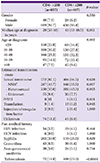1. Hermans SM, van Leth F, Manabe YC, Hoepelman AI, Lange JM, Kambugu A. Earlier initiation of antiretroviral therapy, increased tuberculosis case finding and reduced mortality in a setting of improved HIV care: a retrospective cohort study. HIV Med. 2012; 13:337–344.

2. Kiertiburanakul S, Boettiger D, Lee MP, Omar SF, Tanuma J, Ng OT, Durier N, Phanuphak P, Ditangco R, Chaiwarith R, Kantipong P, Lee CK, Mustafa M, Saphonn V, Ratanasuwan W, Merati TP, Kumarasamy N, Wong WW, Zhang F, Pham TT, Pujari S, Choi JY, Yunihastuti E, Sungkanuparph S. TREAT Asia HIV Observational Databases (TAHOD). TREAT Asia Studies to Evaluate Resistance (TASER). Trends of CD4 cell count levels at the initiation of antiretroviral therapy over time and factors associated with late initiation of antiretroviral therapy among Asian HIV-positive patients. J Int AIDS Soc. 2014; 17:18804.

4. Asfaw A, Ali D, Eticha T, Alemayehu A, Alemayehu M, Kindeya F. CD4 cell count trends after commencement of antiretroviral therapy among HIV-infected patients in Tigray, Northern Ethiopia: a retrospective cross-sectional study. PLoS One. 2015; 10:e0122583.

5. Yamashita TE, Phair JP, Muñoz A, Margolick JB, Detels R, O’Brien SJ, Mellors JW, Wolinsky SM, Jacobson LP. Immunologic and virologic response to highly active antiretroviral therapy in the Multicenter AIDS Cohort Study. AIDS. 2001; 15:735–746.

6. Kelley CF, Kitchen CM, Hunt PW, Rodriguez B, Hecht FM, Kitahata M, Crane HM, Willig J, Mugavero M, Saag M, Martin JN, Deeks SG. Incomplete peripheral CD4+ cell count restoration in HIV-infected patients receiving long-term antiretroviral treatment. Clin Infect Dis. 2009; 48:787–794.

7. Baker JV, Peng G, Rapkin J, Abrams DI, Silverberg MJ, MacArthur RD, Cavert WP, Henry WK, Neaton JD. Terry Beirn Community Programs for Clinical Research on AIDS (CPCRA). CD4+ count and risk of non-AIDS diseases following initial treatment for HIV infection. AIDS. 2008; 22:841–848.

8. Cohen MS, Chen YQ, McCauley M, Gamble T, Hosseinipour MC, Kumarasamy N, Hakim JG, Kumwenda J, Grinsztejn B, Pilotto JH, Godbole SV, Mehendale S, Chariyalertsak S, Santos BR, Mayer KH, Hoffman IF, Eshleman SH, Piwowar-Manning E, Wang L, Makhema J, Mills LA, de Bruyn G, Sanne I, Eron J, Gallant J, Havlir D, Swindells S, Ribaudo H, Elharrar V, Burns D, Taha TE, Nielsen-Saines K, Celentano D, Essex M, Fleming TR; HPTN 052 Study Team. Prevention of HIV-1 infection with early antiretroviral therapy. N Engl J Med. 2011; 365:493–505.

12. The Korean Society for AIDS. The 2013 clinical guidelines for the diagnosis and treatment of HIV/AIDS in HIV-infected Koreans. Infect Chemother. 2013; 45:455–461.
13. Kiertiburanakul S, Boonyarattaphun K, Atamasirikul K, Sungkanuparph S. Clinical presentations of newly diagnosed HIV-infected patients at a university hospital in Bangkok, Thailand. J Int Assoc Physicians AIDS Care (Chic). 2008; 7:82–87.

14. Korean Society for AIDS. The 2015 clinical guidelines for the treatment and prevention of opportunistic infections in HIV-infected Koreans: guidelines for opportunistic infections. Infect Chemother. 2016; 48:54–60.
15. Kee MK, Lee JH, Kim GJ, Choi BS, Hong KJ, Lee JS, Kim SS. Decrease of initial CD4+ T-cell counts at the time of diagnosis of HIV infection in Korea; 1988-2006. Int J STD AIDS. 2010; 21:120–125.

16. Pernas B, Mena A, Cañizares A, Grandal M, Castro-Iglesias A, Pértega S, Pedreira JD, Poveda E. Trends on epidemiological, virological, and clinical features among newly diagnosed HIV-1 persons in Northwest Spain over the last 10 years. J Med Virol. 2015; 87:1319–1326.

17. Delpech V, Brown AE, Croxford S, Chau C, Polavarapu V, Cooper N, Rooney G, Yin Z. Quality of HIV care in the United Kingdom: key indicators for the first 12 months from HIV diagnosis. HIV Med. 2013; 14:Suppl 3. 19–24.

18. Shen Y, Lu H, Wang Z, Qi T, Wang J. Analysis of the immunologic status of a newly diagnosed HIV positive population in China. BMC Infect Dis. 2013; 13:429.

19. Shen Y, Wang J, Qi T, Wang Z, Lu H. Trends in clinical characteristics of HIV-infected patients initiating antiretroviral therapy in Shanghai from 2006 to 2011. Int J STD AIDS. 2013; 25:504–510.

20. Mutimura E, Addison D, Anastos K, Hoover D, Dusingize JC, Karenzie B, Izimukwiye I, Mutesa L, Nsanzimana S, Nash D. IeDEA Central Africa Collaboration. Trends in and correlates of CD4+ cell count at antiretroviral therapy initiation after changes in national ART guidelines in Rwanda. AIDS. 2015; 29:67–76.

21. Miranda AC, Moneti V, Brogueira P, Peres S, Baptista T, Aldir I, Ventura F, Borges F, Mansinho K. Evolution trends over three decades of HIV infection late diagnosis: the experience of a Portuguese cohort of 705 HIV-infected patients. J Int AIDS Soc. 2014; 17:Suppl 3. 19688.

22. Lesko CR, Cole SR, Zinski A, Poole C, Mugavero MJ. A systematic review and meta-regression of temporal trends in adult CD4(+) cell count at presentation to HIV care, 1992-2011. Clin Infect Dis. 2013; 57:1027–1037.












 PDF
PDF ePub
ePub Citation
Citation Print
Print



 XML Download
XML Download